More Odds and Ends: Theros Beyond Death
Last week, I started answering your questions about Theros Beyond Death. This week, I keep doing that.

The one card that jumps to mind is Haktos the Unscarred. He's based on the Greek hero Achilles whose mother dipped him into the river Styx to make him invulnerable. He was killed when someone fired an arrow into his heel, the only place he wasn't invulnerable as it was where his mother held him to dip him. This story is where the term Achilles's heel comes from. In original Theros, Ethan Fleischer designed the following card:
RU03
Achilles
4UU
Creature – Human Soldier
5/5
Protection from each converted mana cost except 5.
We put it in the file, but somewhere between design handoff and print, it got cut. I believe Ethan put it back into Journey into Nyx, the set he led the design for at the end of the block, but once again it got cut later in the process. Following my lead of reaching print through persistence, Ethan put it into Theros Beyond Death during vision design, slightly tweaked, and this time it stayed resulting in this card:
The one other card that I can think of was this card:
It represents the mirror shield Perseus used to fight Medusa. I don't know why it was cut last time. I assume just a numbers thing.
The card in Theros I designed that I was saddest got cut was a card based on Hercules.
Hercules
2GG
Legendary Creature – Human God
12/12
CARDNAME cannot attack or block unless you control twelve permanents.
We would later do this card as a whole mechanic called ascend in Rivals of Ixalan (although created in parallel design), so I tried my hand in doing another Hercules. (Sadly, I couldn't find my design. Just assume it was awesome.) Set Design ended up adding Demigods, so my Hercules got cut.
Those are the only three I can think of, and only two even made it into the set.
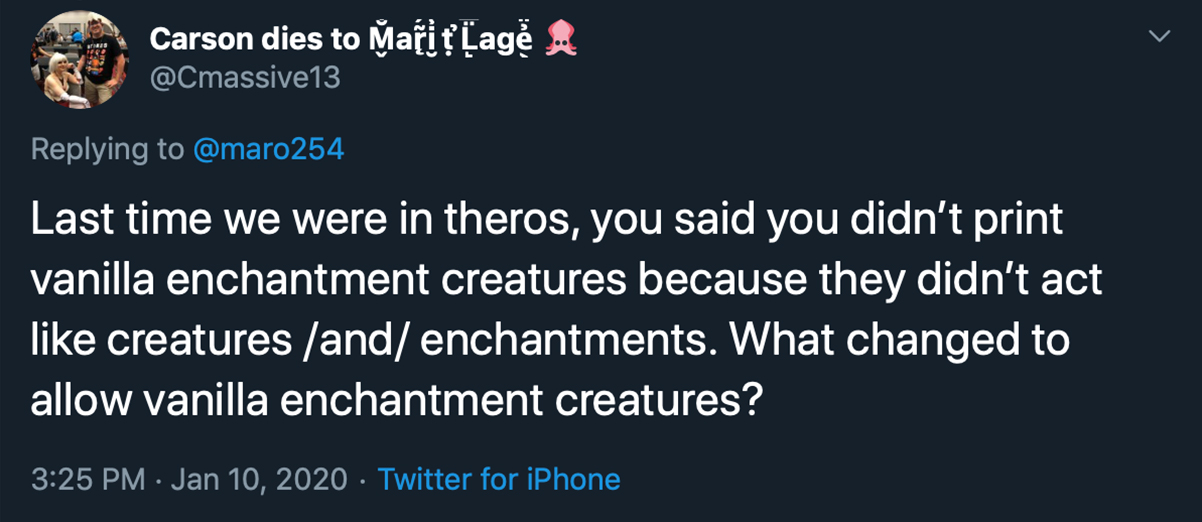
My thoughts on what an enchantment creature is supposed to be has changed since original Theros. Back then, I thought it was very important that it showed off its enchantmentness, so I laid down rules that every enchantment creature had to have text to make it feel like an enchantment. One of the lessons I learned from original Theros block was this restriction got in our way and made it harder to make "enchantments matter" work simply.
Also, since then, I've come to the conclusion that Alpha should have just had enchantment creatures that were enchantments because the flavor says they're made out of magic, such as illusions. I believe artifacts have had so many more sets where they mattered because the existence of artifact creatures helped create an as-fan where we could make synergies work. If enchantment creatures had just been an evergreen thing that most sets used, I believe enchantments would be integrated thematically in more sets.
All of this came to a head when we decided to return to Theros. I said it was fine to have enchantment creatures that were only enchantments because of flavor, and we made a bunch of vanilla and French vanilla enchantment creatures in vision design. Set Design rolled that back a little and just kept one cycle of common vanilla creatures, each with multiple colored mana in their mana cost, so they could help with the as-fan of both "enchantments matter" and devotion.
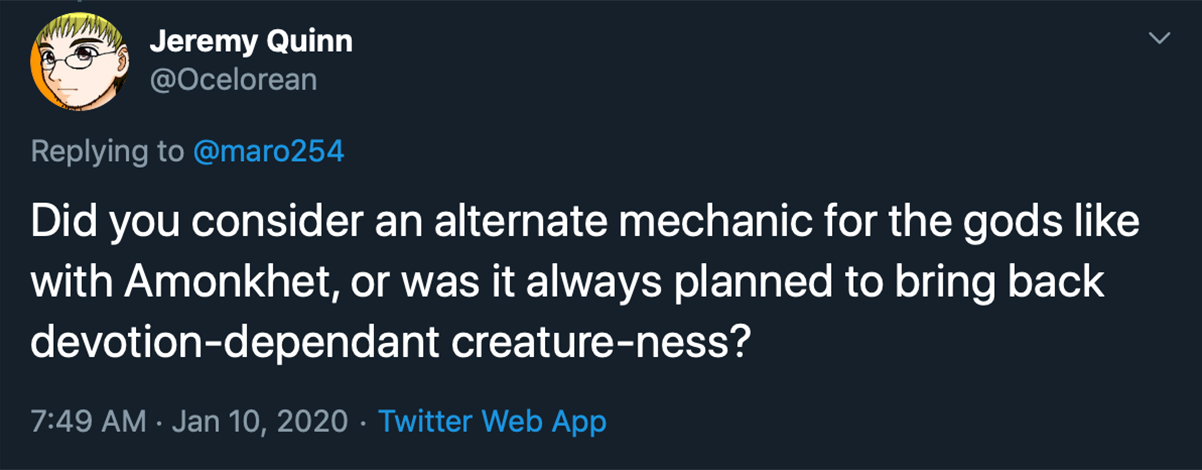
We talked about it a little, but there are a few reasons we chose not to do that:
One, we knew we wanted to bring back devotion. The tie between the Gods and devotion was a slam-dunk flavor win and one of the best parts of its use in original Theros, so it seemed silly not to play that up again.
Two, because the Gods of Theros are enchantment creatures, it allows them to have a noncreature state. That isn't an option we have on most Gods, so it seems to be something we should take advantage of while we have it.
Three, We would be fighting a lot of expectation to do something else meaning there's a high bar to change.
Four, we felt we had the designs to make it work.

Commander is a very popular format. We've stated that we're doing a number of things to promote Commander, and one of them is raising the number of legendary creatures, on average, in a set. Every set isn't going to be at Dominaria levels as that requires having a "legendaries matter" theme, but we are trying to set the default higher than it has been. This also includes us being more willing to do legendary creatures at uncommon.
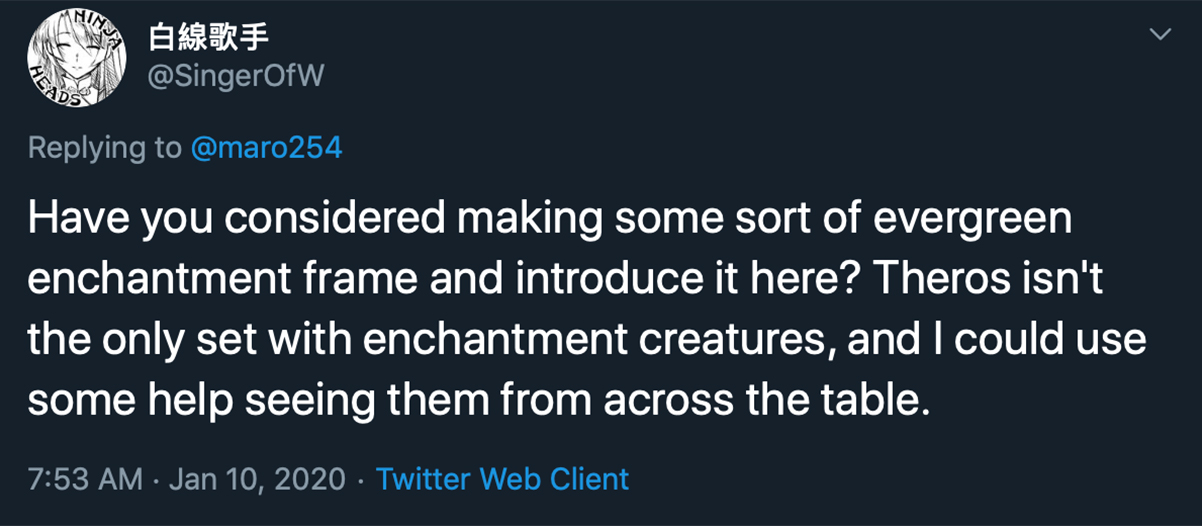
The idea of creating a more universal enchantment creature frame has come up. Theros Beyond Death is an odd place to introduce it though as we have a preexisting frame for it that's tied to Theros. So, for this set, we have a slightly tweaked version of the Nyx frame. If we have another set that has enchantment creatures show up, especially if in number, we'll examine whether enchantment creatures are supposed to have their own general-use frame. I personally am a fan of such a thing because I believe it will make it easier to throw just a few enchantment creatures in a set, something I'm eager to experiment with.
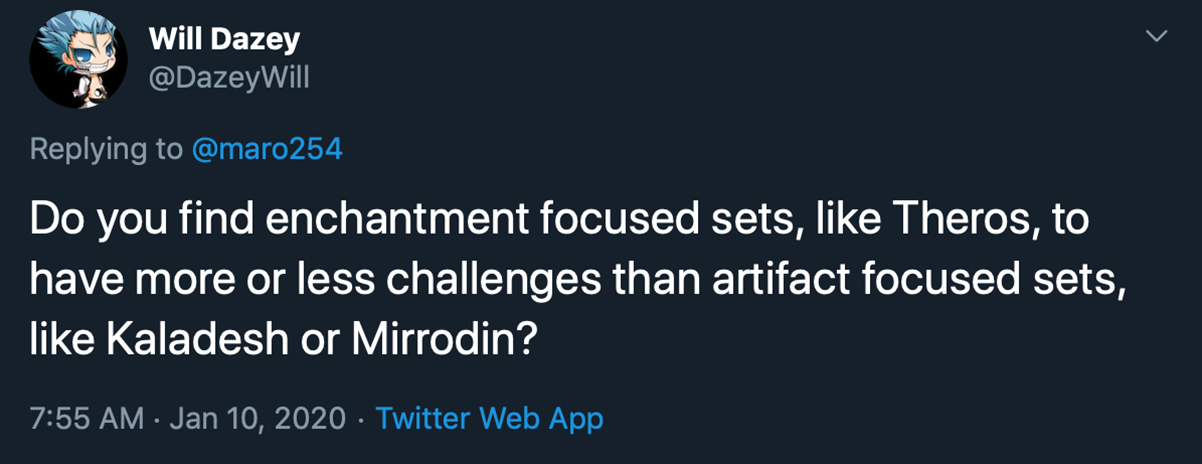
Enchantment-focused sets are harder because we have a lot more restrictions placed on enchantments. Artifacts are pretty versatile which makes designing around them a bit easier. The biggest problem we've had with artifacts has been the generic mana as it allows broken cards to end up in every deck, but R&D's willingness to embrace colored artifacts has gone a long way to solving that problem.
I'll give you an example of a common problem we have with enchantments. Let's say I want to care about enchantments. In a normal set, one without enchantment creatures, enchantment as-fan is quite low. We just don't put a lot of enchantments at common, mostly just a handful of auras. Auras are already problematic because they tend to cause card disadvantage, so it's near impossible to get enough enchantments into a deck to care about them. This is why enchantment creatures were essential in Theros.
As I explained above, I even lost the fight to getting French vanilla enchantment creatures. Artifacts get to do that every set without anyone even looking twice. There are just a lot of things you need to do to get enchantment sets to work that require a lot of push in design. So yes, enchantment sets have a lot more challenges.

I'll give the blunt answer and then the subtle answer.
Blunt answer: The theme wasn't popular enough. There's so much popular stuff that we're trying to fit in from the last visit, while still leaving room for new things, that we simply can't include everything. This leads us to prioritizing things that were popular last time to increase the number of players we can make happy. Minotaur tribal is just too low on the list.
Subtle answer: I believe we made a creative error in original Theros block. World Building liked the idea of more feral Minotaurs. To match the flavor, they made a call to limit Minotaurs to 2/3 or bigger. (We did make an exception later in the block.) It's very hard, especially in a tribe based partially in red, to not have one and two drops in your tribe. Tribal play, especially combat-oriented tribal play, is about hitting your curve and keeping up pressure. Not being able to start applying pressure until turn three just made the Minotaurs too weak. Popularity is influenced by power level, so having an underpowered tribe, one that didn't even work all that well in Limited, soured players on the theme, which is why it doesn't score all that well in market research. The theme did best in casual Constructed where people could supplement with Minotaurs from other sets to help fill in some of the gaps, but that wasn't enough people to raise overall player reaction.

It's much harder for a set throwing forward than a set reacting backwards to create synergy because the early set doesn't know what the later set is going to be doing in enough detail to create the synergy. For example, we knew in Throne of Eldraine that we were going back to Theros, but we didn't know quite what that meant. Yes, we assumed that we would be using devotion, so we layered in a monocolor theme, including the adamant mechanic, that we knew could interact with it, but we had no idea how devotion was going to be crafted specifically, or even in what colors it was going to be focused.
Had we known escape was going to be a thing, we could have toyed with mechanics that helped get cards into your graveyard, but a) we didn't know of escape's existence and b) we can't add things to a set if they're not working well with the themes within that set.I do think adventures and food are modular enough that you can play cards in Theros Beyond Death-centric decks, but yes, there aren't any strong synergies beyond monocolor found in the mechanics of Throne of Eldraine.

Part of helping white is looking at rules we've set for it and reevaluating them. Because white is the weenie color, early Magic had a rule that white didn't get anything higher than 3 power at common and, even then, mostly 2-power. Back then, only blue and green got a creature with a power over 4 at common—at sometimes they were the only ones over 3-power. Over the years, we broke down all the other color's rules, but for some reason, white kept its "no power over 3 at common" rule. One day, we looked at that and said, "Does that have to be the case?" And we answered, "No."
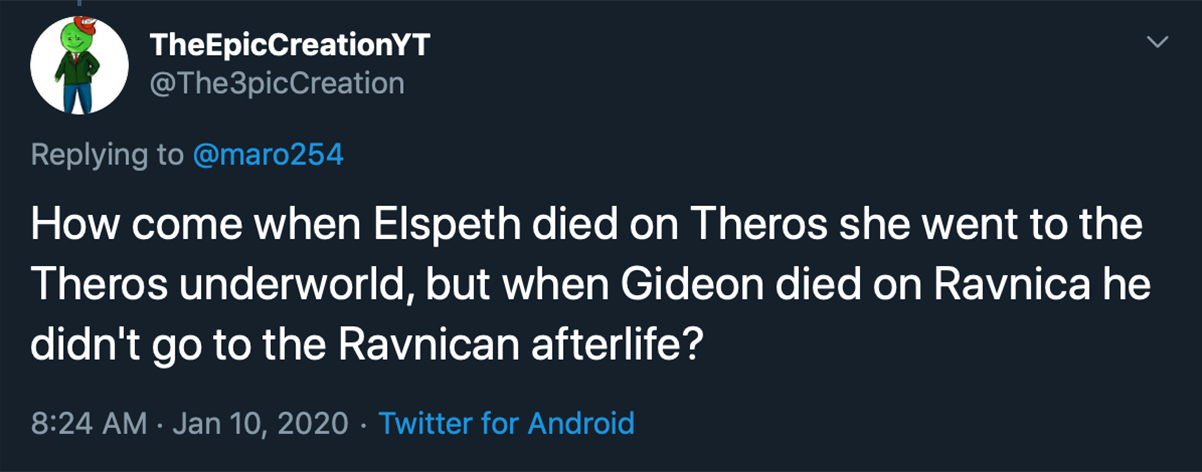
Ravnica doesn't have an underworld like Theros, but it does have its own form of an afterlife. Becoming a ghost seems to be the fate of those who "live" beyond their death on Ravnica. I'm not sure under what circumstances you become a ghost on Ravnica, but that is a possible outcome of dying there.

I'm skeptical Sagas will ever become evergreen as it's not the kind of thing we're going to do every set (they're hard to design and require worlds with stories the audience knows). What I think you're really asking for is for it to become deciduous, meaning any set has access to it and that it can show up with more frequency than a normal non-evergreen mechanic. The fate of that has a lot to do with how Sagas are received. The more players say they like them, the sooner they're likely to return.
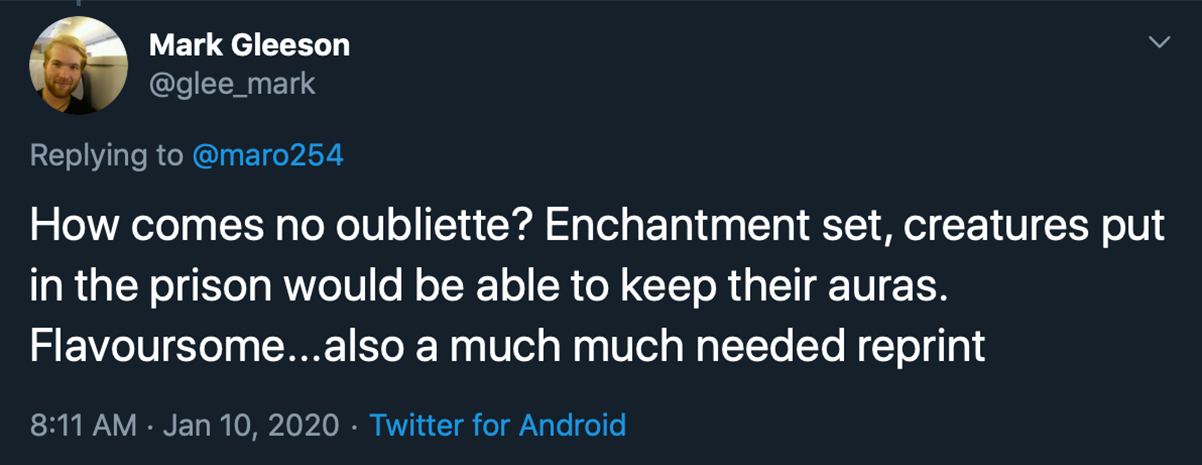
Basically two reasons:
One, reprints have to keep the same name, and an oubliette is not particularly Greek in origin. It's a French word.
Two, cards in Standard-legal sets follow the modern color pie and the ability is now a white ability, not a black ability.
That's why it's not in Theros Beyond Death. I am happy to say we found a way to template it so it can fit on a card (that's the real reason we haven't done it for so long), and it is planned to be reprinted in an upcoming product.
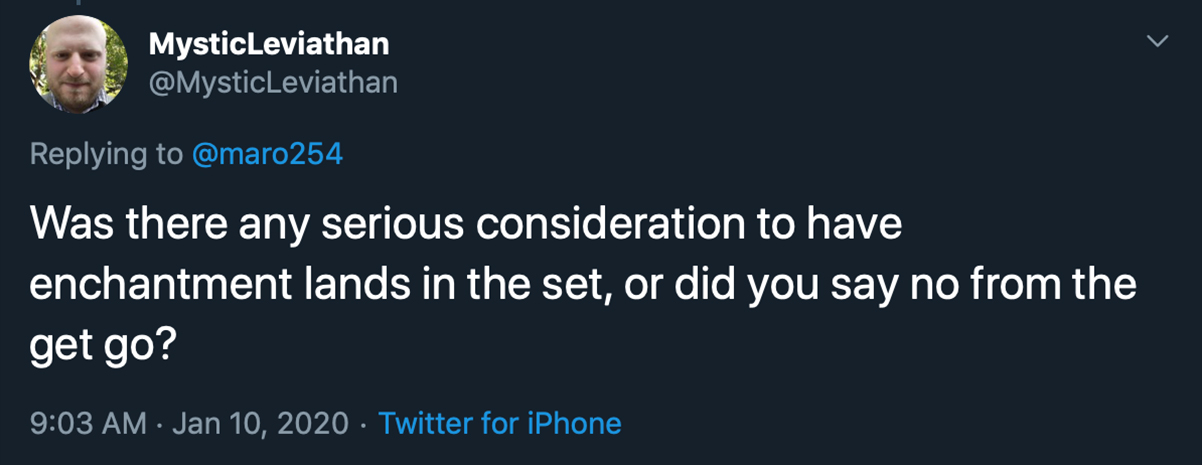
In original Mirrodin, we made artifact lands. That went very badly for us and we ended up having to ban them in numerous formats. As they say, once burned, twice shy. We've been extra careful about making enchantment lands. We did talk about having one in Theros Beyond Death, but once we knew constellation was in the set, it was a non-starter. You see, constellation plus an enchantment land is super powerful, which means we'd have to weaken all the constellation cards if we wanted to have the enchantment land. That trade-off doesn't seem worth it, so once constellation was locked in, it was pretty clear we weren't going to make an enchantment land. Perhaps one day, most likely in a set without an "enchantments matter' theme, we'll make one.

One of the things we monitor is a thing we call vocabulary management. When you start playing, how many new words are you forced to learn. Note by new words, I don't just mean words you've never seen before, but words that have an in-game meaning that you have to learn. If you exceed a certain threshold, the game becomes intimidating enough that it drives new players away.
There are several things we do to adjust for vocabulary management:
One, we're careful about how many keywords any one set has. This is a combination of the evergreen keywords (vocabulary in almost every set such as flying) combined with any deciduous keywords (vocabulary that shows up from time to time, but isn't in every set such as crew), and set keywords (vocabulary unique to this set, such as escape in the case of Theros Beyond Death).
Two, we're careful about the as-fan of the new vocabulary in the set. We want to make sure that a new player will be introduced to new vocabulary at a rate they can handle. We accomplish this by being careful about what vocabulary shows up at what rarity.
Three, we're careful about how hard each keyword is and make sure to have less of the harder-to-understand words. Flying, for example, actually helps comprehension as it's such a perfect mechanical fit for its name. Vigilance, in contrast, does little to explain what's going on and is just a term you have to learn.
Four, we're careful about when and how we use reminder text. Reminder text doesn't undo all of the intimidation of new vocabulary, but it can help.
The result of all this is that we've decided not to use keywords if a mechanic isn't evergreen, deciduous, or a major player in the set. If there's one card that uses landfall, we just write it out and don't label it as landfall, because it's much less intimidating as a card that just does a thing. The heroic case is interesting as it appears on five cards, which is around the threshold we consider using a vocabulary word. All the cards do the exact same thing, that is, they have the same effect. Normally, heroic cards have the same trigger, being targeted, but different effects. After much discussion, we decided labeling it would cause more strain than not labeling it, so we didn't.
Whenever I explain this policy, the counter I get is how labeling cards that use an old mechanic would make it easier for established players to recognize what the card does. It also makes it easier to search for when you're building a deck around a mechanic. Our answer is that we're willing to put a slightly larger burden comprehension-wise on our more established players in an attempt to help newer players get into the game. I often talk about how Magic's barrier to entry is probably its biggest weakness as a game, so I find this concession important. Note that this isn't changing gameplay at all, just adjusting how easy it is for different players to understand what's going on. If we can lay complication on one side of the spectrum or the other, our answer is always going to be on the side of the more enfranchised player. Basically, we trust you all can handle it better.
Game Over
My time's up for today. I want to thank everyone who took the time to send in a question, and I'm sorry if I didn't get a chance to get to yours. As always, I'm eager to hear your thoughts on my answers or on the new set. You can email me or contact me through any of my social media accounts (Twitter, Tumblr, and Instagram).
Join me next week when I finally get to talk about the design of Unsanctioned.
Until then, may you find a way to become myth.
#709: Black-Red
#709: Black-Red
35:28
This is another in my two-color philosophy series. This time I talk black-red.
#710: Success Paralysis
#710: Success Paralysis
53:38
In this podcast, I talk about a phenomenon known as success paralysis where being successful can discourage you from embracing change.
- Episode 708 Tempest Cards, Part 4
- Episode 707 Tempest Cards, Part 3
- Episode 706 Blue-Black

